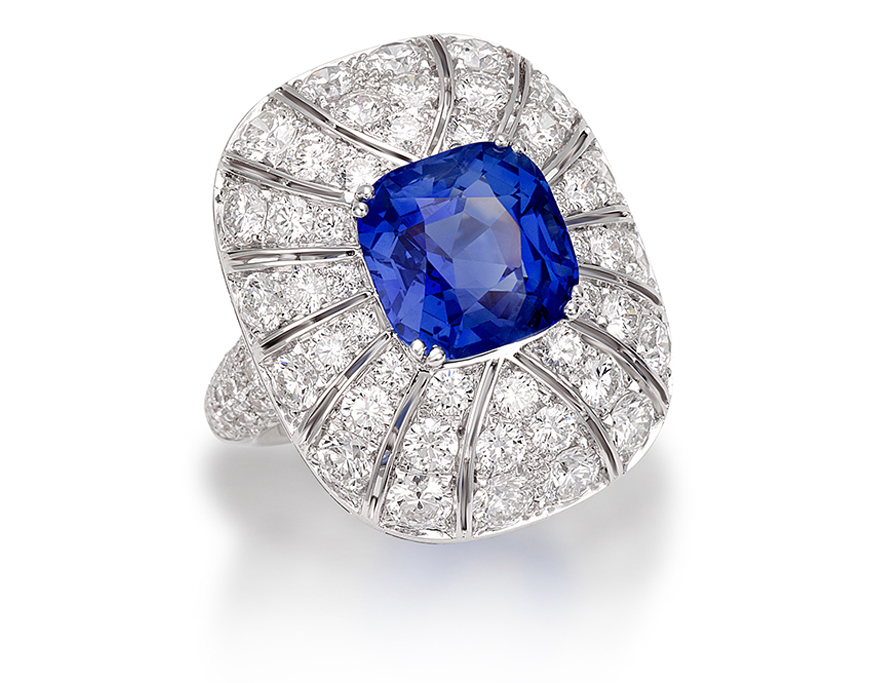How to Buy Sapphires – A Luxury Guide for Selecting the Highest Quality
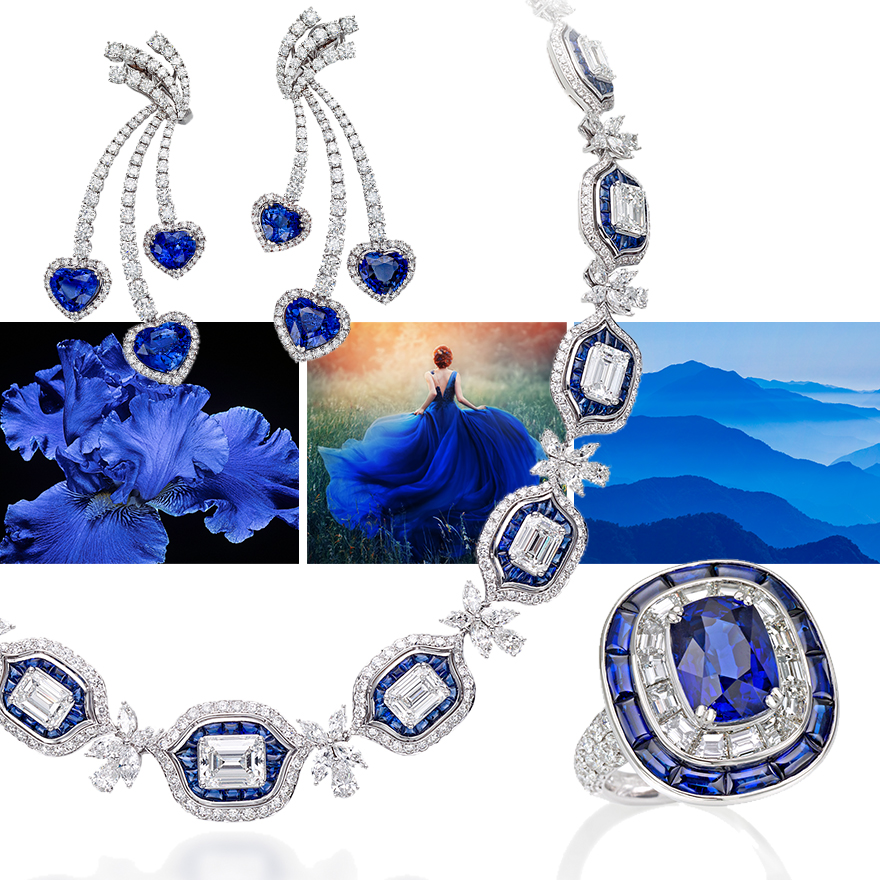
“Sapphires captured my heart from the very start,” says Giuseppe Picchiotti, founder and designer of the 54-year-old PICCHIOTTI fine jewelry brand. “As the young apprentice of a master jeweler, when I was just a teenager, I found myself captivated by the magic of the profound cerulean color of the Sapphire. These treasured gems hold the vastness of the sky and the depth of the ocean in their beautiful, deep blue hues. I love to design with them – it’s like making water or the heavens wearable!”
The precious and sparkling Sapphire is the birthstone for September. Its remarkable hues and history are a fascinating source of inspiration and delight for its fans. Some etymologists believe the name comes from the Greek “sappheiros” which translates as “blue stone,” but others attribute it to the Hebrew word “sappir” which means “the most beautiful thing.” At PICCHIOTTI, Sapphires are believed to be the most beautiful blue things on the planet.
According to the American Gem Society, Sapphires symbolize loyalty, nobility, sincerity and integrity. Not only are these gems rare and beautiful, they are also a favorite of Giuseppe Picchiotti. He has been buying the very best quality Sapphires for over fifty years. His expertise shines a light on how to buy Sapphires, and true to PICCHIOTTI style, how to select the very finest quality.
Definition & Origin – What Are Sapphires and Where Do They Come From?
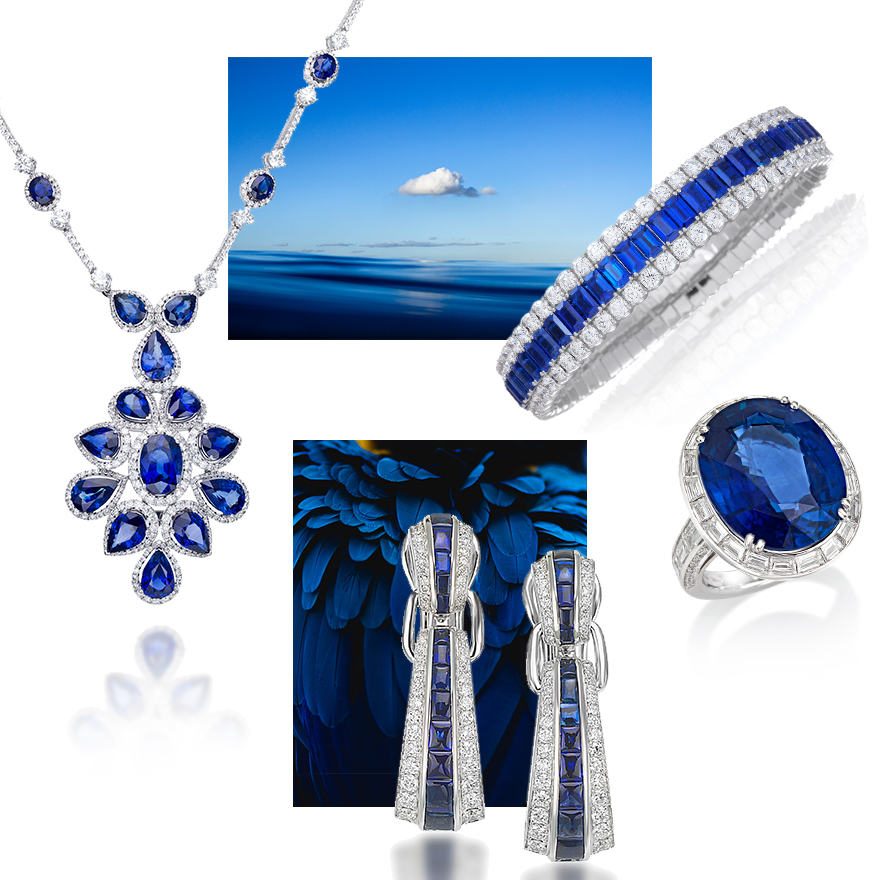
Clockwise from upper left – PICCHIOTTI Sapphire Floral Pendant necklace set in 18K White Gold, Xpandable™ Sapphire and Diamond Bracelet, PICCHIOTTI Masterpieces Sapphire and Diamond Ring, PICCHIOTTI Art Deco Diamond and Sapphire Earrings
Sapphires are a form of the naturally occurring mineral corundum which is a crystalline form of aluminum oxide. The rock-forming mineral corundum is naturally transparent, but it can have different colors depending on its trace mineral content. Traces of titanium will create the blue color that is typically associated with Sapphires. Traces of chromium in its crystalline structure will produce pink Sapphires. In fact, Sapphires can occur naturally in all colors of the spectrum, except red – the red corundum is labeled ruby. (Learn more about rubies in our recent July blog post.)
As a precious gemstone, Sapphires are valued in part for their strength and for their incredible durability. With a hardness rating of 9 on the Mohs hardness scale, Sapphires are just under Diamonds (which have a score of 10). Like all precious gems, these remarkable stones stand the test of time and can be passed down from one generation to the next. For this reason, Sapphires are sometimes used in engagement rings. In 1981, Sapphires became a symbol of royal love when Great Britain’s Prince Charles gave Lady Diana a 12-carat blue Sapphire engagement ring. More recently, Prince William gave that same ring to Kate Middleton when he proposed in 2010. PICCHIOTTI’s new bridal collection offers Sapphire and diamond styles in engagement rings, all set with their patented Xpandable™ technology (on select styles) which solves the problem of ring sizing or poorly fitting rings because of large knuckles (see example below).
In terms of origin, the most famous type of Sapphire – the deep beautiful blue – traditionally, the highest quality came from Kashmir, at the northern most tip of the Indian subcontinent. But today, Kashmir Sapphires are extremely rare as most of the existing material was mined well over 100 years ago. Considered the absolute pinnacle of all sapphires, the near-perfect Kashmir specimens continue to be highly sought after. They have a superior cornflower blue hue which has been described as “blue velvet.” Now extremely rare, Kashmir Sapphires have a world-renowned and almost mythological reputation which drives their prices at auction to record-setting highs. The world record price-per-carat for Sapphires was set by a Kashmir Sapphire, which sold at auction for $242,000 per carat (more than $6.74 million total) in October of 2015.
Today, the highest quality Sapphires are more likely to come from Myanmar (formerly Burma) and Sri Lanka (formerly Ceylon). An exceptional oval Sapphire weighing 18.16 carats from Sri Lanka is surrounded by a flawless outline of PICCHIOTTI’s signature baguette diamonds in this ring set in 18K white gold. Occasionally, some nice quality stones also come from Thailand. The Sapphires in the Xpandable™ Sapphire bracelet featured above came from the Thai province of Kanchanaburi.
A highly trained eye like Giuseppe Picchiotti’s ensures a perfect selection of the most superlative gems from these regions. Along with his sons Filippo and Umberto, he travels regularly around the world to directly inspect the materials closely, using a jeweler’s loupe, to make sure that each stone meets the high PICCHIOTTI standards of color and cut. They travel to gem shows and often try to visit the source or the gem dealers very near the source. Mr. Picchiotti’s goal has always been to buy the very finest quality gems to make his jewelry designs stand out from the crowd. According to him, the most important quality factors that distinguish one Sapphire from another are color and cut.
Color – How to Pick the Very Best Shade of Blue
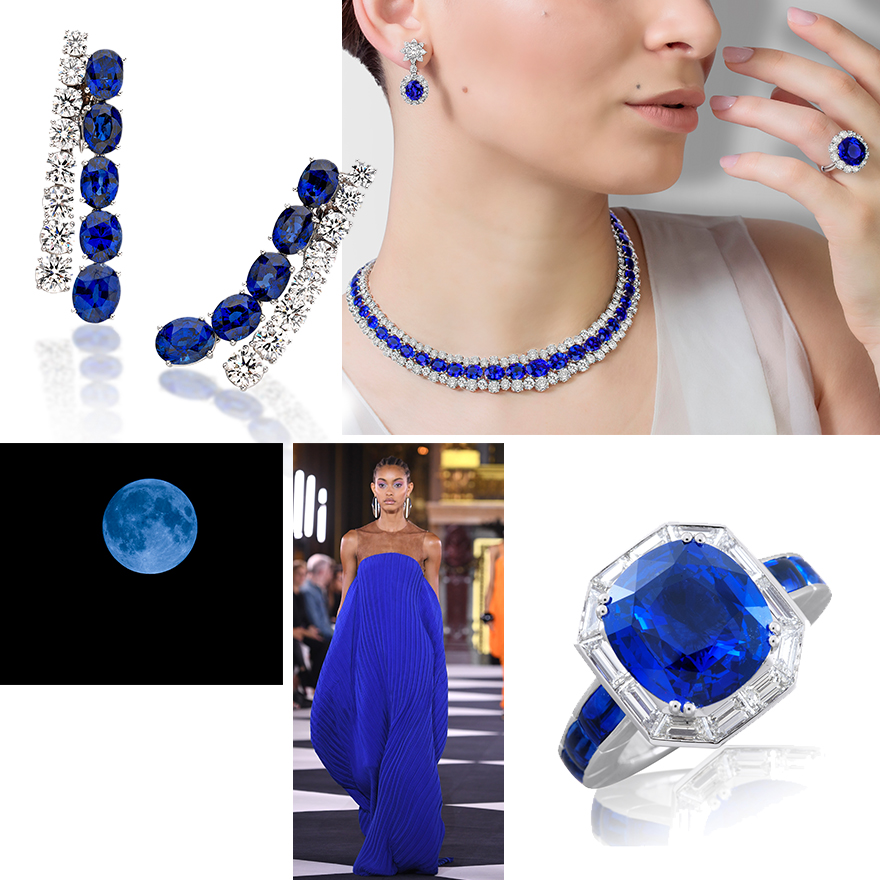
Clockwise from upper left – Masterpieces Sapphire Earrings, Model wearing PICCHIOTTI Masterpieces Necklace, Earrings and Ring, PICCHIOTTI Xpandable Sapphire cocktail ring, Balmain Paris S/S 2020
As mentioned above, Sapphires can come in a wide variety of colors (all but red/ruby), but the finest and most highly prized Sapphires are typically the blue ones. Sapphires come in many shades of blue, from pale baby blue to royal blue. When examining a Sapphire, one of the first things to look at is its unique shade of blue. The Picchiotti family looks for perfection in deep, velvety blue hues, in medium to medium-dark tones. A high-quality blue sapphire will never be black or purplish/pinkish. The saturation of color throughout the gem is critical. Note how each of the graduating oval Sapphires in the undulating Masterpieces Collection earrings shown above have a magnificent depth of color.
Because corundum is a naturally translucent mineral, sapphires typically sparkle when they are faceted and beautifully cut. That play of light affects the color, as well. If a Sapphire has consistency of that deep blue velvet color throughout, even with faceting and light refraction, it is considered a superlative stone. The best way to examine color is with the naked eye in very good lighting. Turn the stone on all sides and see how it sparkles, while also looking for any blackness or purple/pink hues. Keep in mind that color is completely dependent on light, so keep turning the stone to allow the light to shine into all the facets. The “true blues” of a great Sapphire will captivate the attention, like getting lost in a vision of the sea.
Sapphires of such exceptional quality are often bought as investment gems, as they tend to retain or increase their value over the long haul. A gorgeous unheated cushion-cut Sapphire from Sri Lanka weighing 14.79 carats creates the centerpieces of a rich round diamond framework in a beautifully classic platinum ring by PICCHIOTTI (shown on model). Such a ring represents the epitome of an investment stone, coupled with state-of-the-art Italian craftsmanship to deliver a world-class jewel.
Another important consideration is color matching. Because Sapphires are all distinct, there are no two exactly alike. Jewelers and gem dealers often collect special Sapphires for years to put together a spectacular grouping like the perfect radial layout of octagonal Sri Lankan Sapphires, encircled by large diamonds in the PICCHIOTTI Sapphire necklace (shown on model) from its Masterpieces collection.
Cut – How to Pick the Best Shape for You and for the Stone
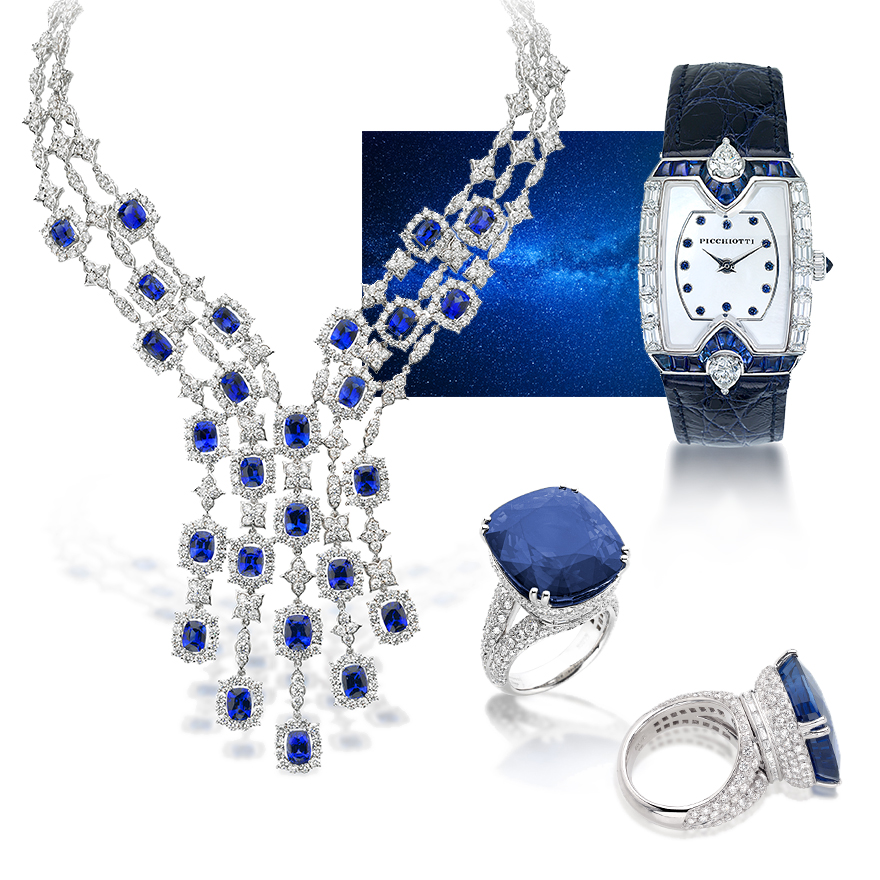
Clockwise from upper left – PICCHIOTTI Statement Cascade Necklace in Sapphires and Diamonds, Calletta Collection Watch by PICCHIOTTI with Sapphires and Diamonds, PICCHIOTTI Masterpieces Sapphire Tower Ring
The cut of a gemstone is all about its shape (round, oval, princess, pear, cushion, baguette, etc.). Apart from personal preference, whether one prefers rounds, ovals, pears, the quality of the cut is crucial. A good cut must always be well proportioned and performed by a well-trained master gem-cutter.
For colorless diamonds, shape is completely a personal preference, so long as the stone has been cut by a master gem-cutter to ensure its maximum brilliance. For colored gemstones like Sapphires, though, shape can often enhance the gem’s color. The best shape for a particular stone may be determined by the crystal structure of the stone itself.
For Sapphires, a few cuts work better than others for bringing out the true beauty of the stone. Sapphires are formed with a hexagonal crystalline structure, so rounds, ovals and cushions are most popular because these cuts bring to life the sparkle and refraction of the light, while also ensuring durability with regular wear. Rounds and ovals are most common.
Giuseppe Picchiotti, however, is partial to cushion-cut sapphires. “My favorite shape is the cushion cut. It is a gentle, feminine shape that really does justice to the most exquisite designs.” This is why many of the PICCHIOTTI Sapphire Masterpieces have been styled with cushion-cut Sapphires. As an example, a stunning 34.69 carat cushion Sapphire is the center of a tower ring that truly elevates and highlights the perfection of the stone. Another example of a cushion-cut design is the dazzling cascade necklace above featuring 27 cushion Sapphires framed in a stunning diamond chute.
PICCHIOTTI also specializes in fancy cuts. Many have been used over the years to create their unusual and award-winning designs. For example, the Blue Heart earrings feature six heart-shaped Sapphires in an incredible cascade (see feature image above); they are complemented by an extraordinary matching necklace.
PICCHIOTTI has also been using Sapphires to create their famous color accents for some of their most iconic designs. The unique buff-top cut is often used for accent Sapphires in some of the most outstanding Masterpiece designs. The buff-top baguette is a rare and quite sophisticated cut, as each Sapphire needs to be carefully recut to make the design come to life. Examples include one of the eight exclusive watches from The Caletta Collection. The watch is a good example as the buff-top Sapphires gracefully enhance the watch and match the Italian leather watch strap. Also, in the feature image at top, note how the Sapphires frame the stunning array of Emerald-Cut Diamonds, highlighting the shape and magnitude of each brilliant stone.
Clarity – Some Inclusions are Normal
Another of the 4 Cs that relates to gemstones is Clarity. Clarity measures the blemishes, fractures and inclusions that affect a stone’s appearance and beauty. Blue Sapphires do typically have some inclusions. According to the Gemological Institute of America (GIA), “blue Sapphires with extremely high clarity are rare and very valuable.” Sapphires can have a variety of inclusions, such as thin mineral “silk” needles, healed breaks that look like fingerprints, color banding and color zoning. Typically, such inclusions make the stone less valuable, especially inclusions like fractures that threaten the stone’s strength and durability. But with blue Sapphires, sometimes inclusions can increase the value of the stone. For example, GIA reports that many of the famed Kashmir Sapphires have tiny inclusions that scatter the light, causing a beautiful visual effect which gives the stones a velvety appearance without affecting their transparency.
Heat Treatments – Unheated Sapphires Are More Rare and More Valuable
The most common enhancement to Sapphires is heat treatment. The heating of Sapphires can enhance their color and make them more appealing. Heating gemstones dates back hundreds of years and is commonly accepted as a durable treatment to make lower quality stones more acceptable and to make the precious gems more affordable. The treatment is stable and effective and should be long-lasting.
Unheated Sapphires, however, are much rarer. Natural unheated Sapphires are prized for their appearance, their legendary quality, and their enduring intrinsic value. When buying a Sapphire, always ask if the stone has been heat treated. Jewelers are legally required to disclose any treatments to the gems and/or jewelry that they sell. Heat-treated Sapphires can be a very good option for Sapphire lovers who lack the budget to buy the exceptional and rare unheated superlative Sapphires.
Also, always shop from a reputable jeweler that you trust and consider insuring your Sapphires for their full retail value, in case you ever need to replace them. Most jewelry retailers offer gem grading reports with high-quality gemstones. Ask to see the gem report and have the salesperson explain the cut, clarity, color, and carat weights of the gems being purchased. Also look for trusted, heritage brands like PICCHIOTTI who stand behind the beautiful gems that they sell.
Most important, remember to let the beauty of Mother’s Nature’s color palette bring joy and delight as you shop! Supreme quality Sapphires are one of the Earth’s greatest treasures. Enjoy their deep, tranquil blue hues and become mesmerized by the saturation of color. As Giuseppe always says, “The velvety texture of a superlative Sapphire is unique – it’s a special gift from Mother Nature to all who appreciate the intrinsic beauty of this magnificent gemstone.”
Feature image (at top) – Clockwise from upper left – PICCHIOTTI Masterpieces Earrings featuring a Cascade of Heart Sapphires, PICCHIOTTI Statement Necklace featuring emerald-cut Diamonds surrounded by baguette Sapphires, PICCHIOTTI cocktail ring featuring Sapphires and Diamonds
If you liked this, you might also like:
The Baguette Cut Diamond and The Evolution of a Signature Style
How to Buy Rubies – A Luxury Buying Guide for Selecting the Very Finest Quality



